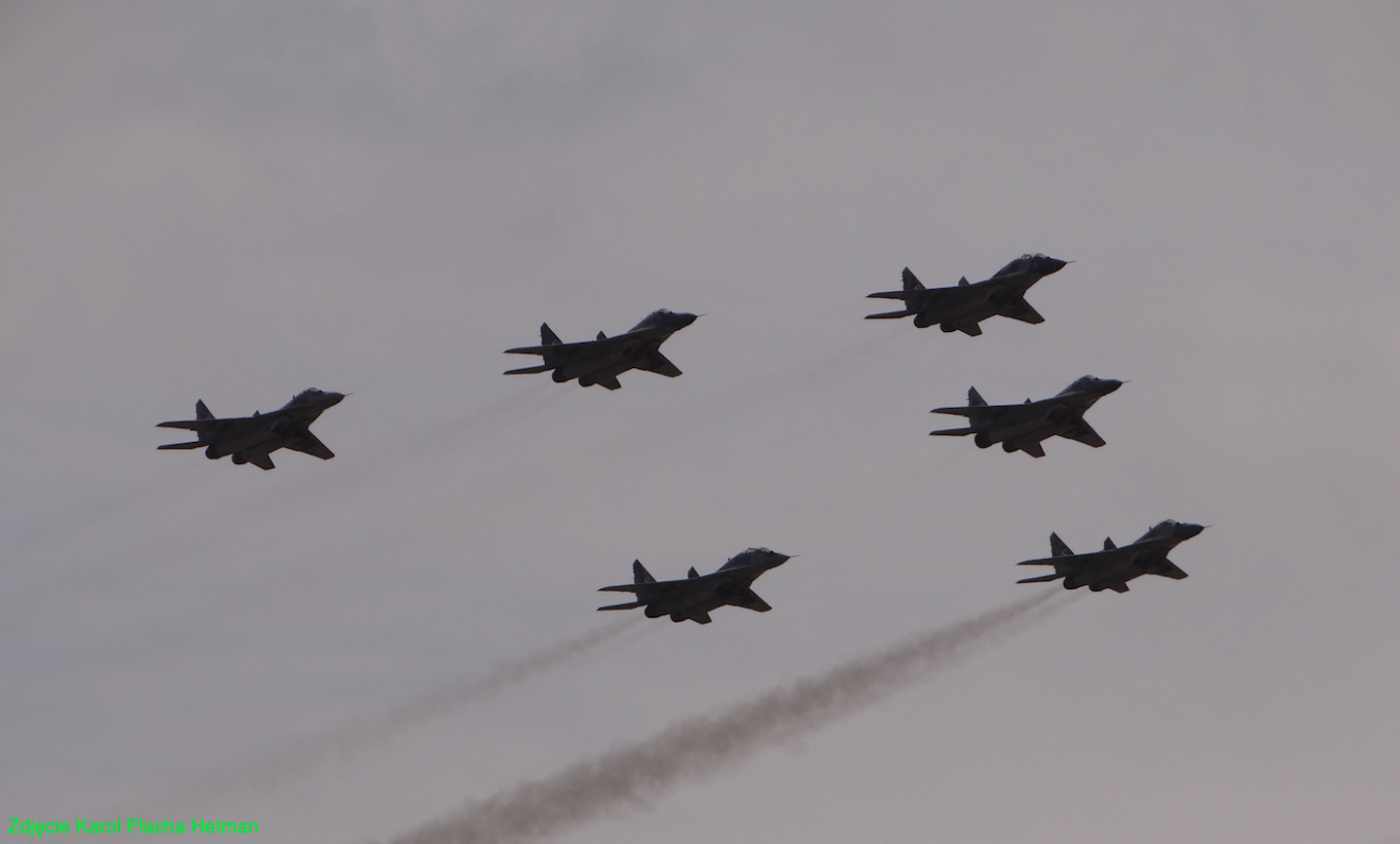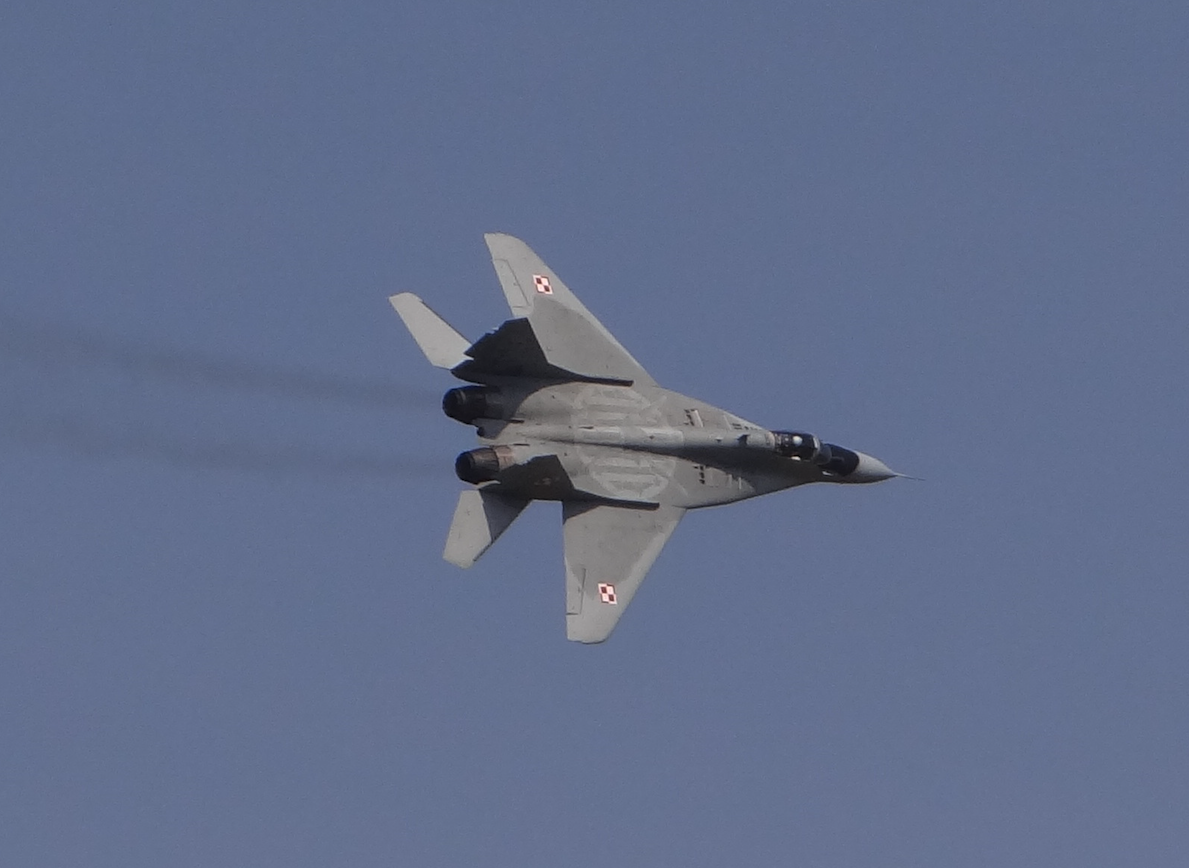Malbork 2018-07-22
MiG-29 tragedy nb 4103 on 2018-07-06.
On July 5, 2018, day and night training flights were carried out at the 22nd Tactical Air Base in Malbork, in which almost the entire staff of the combat unit participated. Among other things, exercises were carried out in intercepting single air targets at low altitude.
At approximately 1:57 a.m. (July 6, 2018), one of the planes crashed. Its pilot managed to catapult, but did not survive. His body was found by rescue services approximately 200 m from the wreck. The doctor who arrived at the scene confirmed the pilot’s death at 2:30 a.m.
The place of tragedy. The accident happened in Sakówko, 18 kilometers east of Malbork, near Pasłęk, Warmian-Masurian Voivodeship.
Pilot Lieutenant Krzysztof Sobański. Age 33. He had approximately 850 hours of flight time, including 500-600 hours on MiG-29 aircraft. He was on combat duty. He took part in national and international exercises many times. He also served in the Polish Military Contingent "Orlik" as part of the NATO Baltic Air Policing mission in Lithuania. He left behind a wife and two children. His funeral took place on July 14, 2018 (Saturday) in Pruszcz Gdański. Minister of National Defense Mariusz Błaszczak promoted him posthumously to the rank of captain. He was also awarded the Gold Medal for Merits in National Defense. Honor his memory!
The plane hit the ground at a small angle and moved several dozen meters before bursting into flames. However, the fire was not large and the fire brigade that arrived at the scene extinguished it. The front part of the fuselage was severely damaged. According to unofficial information, the pilot reported technical problems and had difficulty controlling the plane. He received an order to leave the plane.
On the morning of July 6, 2018, a press conference was held by the Minister of National Defense, Mariusz Błaszczak. Until the disaster is clarified, all MiG-29 flights have been suspended. The minister assured that the family would be cared for. The circumstances of the accident were investigated by the State Aviation Accident Investigation Commission. “This is a huge tragedy for me and all soldiers of the armed forces. I express my condolences to the family of the tragically deceased pilot and to our entire military family.” – said Minister Mariusz Błaszczak. In turn, Colonel Pil. Maciej Trelka said – “The MiG-29 is an aircraft that has been in service for 29 years. It is a very safe aircraft, and this crash is the first event of this type on this type of aircraft. I would like to ask everyone not to comment on this matter until the commission established for this purpose explains the causes of the incident.” – the officer appealed.
The first speculations of the Masonic-liberal media indicated the possibility of a collision between the plane and another aircraft. The damaged upper part of the left vertical tail was indicated. The media noise was so great that the 22nd Tactical Air Base had to issue a statement that no other aircraft at the base were damaged. The probable damage to the tail was caused by the thrown cockpit fairing or the pilot’s seat. A few days after the disaster, information was published that inspections of the condition of the engines of all aircraft of this type had started at the base in Malbork and Mińsk Mazowiecki.
MiG-29 nb 4103 No. 2960526301 was built in 1989. It belonged to the first export series. It was delivered to the GDR (German Democratic Republic). After the fall of the GDR, the planes were taken over by the Federal Republic of Germany. He was then nb 29+16. The Germans tried to modernize the planes. Because the plans changed many times, the scope of modifications varied and four variants could be distinguished. In 2003, the Germans decided to get rid of these planes. The Polish Republic took advantage of the offer. We paid a symbolic 1 euro each for the planes. However, anyone who thought that the Germans earned nothing would be wrong. The sale was associated with our purchase of 128 Leopard 2 A 4 tanks for specific money, EUR 25 million (PLN 120 million).
Let us recall that the Germans had a total of 24 MiG-29s, one machine was lost and the other was immediately placed in a museum due to significant wear and tear. The agreement concluded between Poland and the Germans states that after the end of their operation in Poland, 5 machines will go to museums in Germany. Poland ultimately received 18 MiG-29 G and 4 MiG-29 GT units from the Federal Republic of Germany. They all flew to Bydgoszcz from Laage one by one; September 30, 2003, 5 machines, including 1 two-seater. On December 11, 2003, 4 machines, including 1 two-seater. On April 14, 2004, 4 machines. On August 4, 2004, 9 machines, including 2 two-seater ones. Together with the planes, we received a lot of parts and 78 engines, 740 k.p.r. (R-27, R-60, R-73) and ammunition for 30 mm guns. The planes were placed at WZL No. 2 in Bydgoszcz. The general overhaul and retrofitting of one aircraft cost approximately PLN 8-11.5 million.
After renovation, the planes were moved to the unit in Malbork. The first in the summer of 2005, the last in 2007. Also in 2007, the first Malbork MiG-29s reached combat readiness. Unfortunately, pilots flying these planes in Malbork cannot pilot planes from Mińsk Mazowiecki due to different equipment and a different dashboard. These planes, in many important details, are significantly different from the MiG-29 used so far in Poland.
MiG-29 aircraft and RD-33 engines are being renovated in Poland. There is no problem with the number of spare engines for MiG-29 aircraft. There are plenty of them. The problem, however, are spare parts for these engines, which are imported from Moscow. Import difficulties have intensified since 2014, when Comrade Vladimir Putin attacked Ukraine, annexed Crimea and shot down a Malaysian passenger plane. As a result, in 2017, the 3rd Logistics Base announced a tender for two RD-33 engines with a resource utilization of less than 350 hours.
Mikojan and Guriewicz MiG-29 aircraft have been in use in the Polish Army for 29 years. They have a good reputation among pilots and ground staff. The twin-engine system has always been cited as increasing safety. Although in reality it doesn’t have to be like that. In the case of a single-engine system, all inspections and repairs must be carried out 100%.
The tragedy of July 6, 2018 was the second accident of this type of machine and the first fatal one in the Polish Army.
A lot of discussion was caused by the ineffectiveness of the use of the K-36 seat installed in several types of combat aircraft, including the Mikoyan and Gurevich MiG-29. This chair gained great recognition after spectacular rescues of pilots during great air shows in the second half of the 1980s. Also, less remembered, during the plane crash in Lviv. It took place on July 27, 2002, during an air show at the Skniłów airport (now Lviv Airport). During an aerobatics demonstration, a Sukhoi Su-27 fighter belonging to the Ukrainian Falcons team crashed into the take-off field. The plane plowed the ground and … the audience. Following the disaster, 77 people died and 543 were injured. Then the Su-27 crew also saved themselves using the K-36 seats. The pilots were sentenced to 14 and 8 years in prison, respectively, for hooliganism in the air. It is true that the K-36 seat is a 0-0 class seat, which means it saves the crew at zero altitude and zero speed. However, when the plane descends, appropriate altitude is needed. When falling at a speed of 10 m/s, a minimum height of 40 m is needed, which is more than a 10-story apartment building.
The tragedy of Polish captain-pilot Krzysztof Sobański had repercussions in other countries that use planes of this type. On July 11, 2018 (Wednesday), the Slovak government decided to purchase 14 Lockheed F-16 Block 70/72 aircraft. They thus rejected the JAS-39 Gripen offer. But what is more important is that the Slovaks intend to suspend the flights of the Mikojan and Guriewicz MiG-29s in operation, and until the Lockheed F-16 planes are delivered, ask other countries for help in monitoring Slovak airspace. It was reported that the RD-33 engines that power their 12 Mikoyan and Guriewicz MiG-29 machines are ending their service life in 2019, because the contract with the Moscow state for their renovation expires.
Therefore, we believe that it was wrong that after the purchase of WSB Lockheed F-16 Jastrząb, the MiG-29 and Su-22 aircraft were not withdrawn from service and used F-16 were not introduced in their place. But this is only our subjective assessment.
Written by Karol Placha Hetman


